https://www.youtube.com/watch?v=Ew-3-8itpjc
How to Make 29 Handmade Pasta Shapes With 4 Types of Dough _ Handcrafted _ Bon Appétit
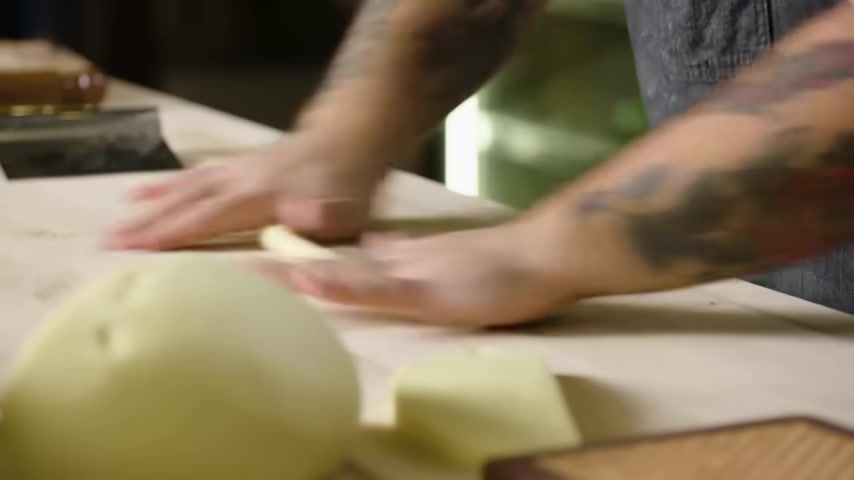
I'm Luca .
I'm the past at Italy flat iron .
And today I'm gonna turn these four pasta dough into beautiful handmade pasta shapes .
First up , we're going to work with this Semolina dough .
So the semolina dough is a Southern Italian specialty .
It's made just with semolina and water .
A lot of times you'll see some of the shapes being made from this more often in your local grocer or maybe specialty markets because without the inclusion of egg , it's easier to preserve .
So when you're rolling into a rope , you wanna use your whole hand and you're slightly spreading your hands apart from the other .
Not too much .
The idea is not to stretch out the dough .
So it pulls or breaks , but you want to put some pressure down and then just even sweeps .
So as to stretch the dough gently .
So the first shape we're gonna make is we wanna take those ropes and we're gonna cut into these nice little even pieces .
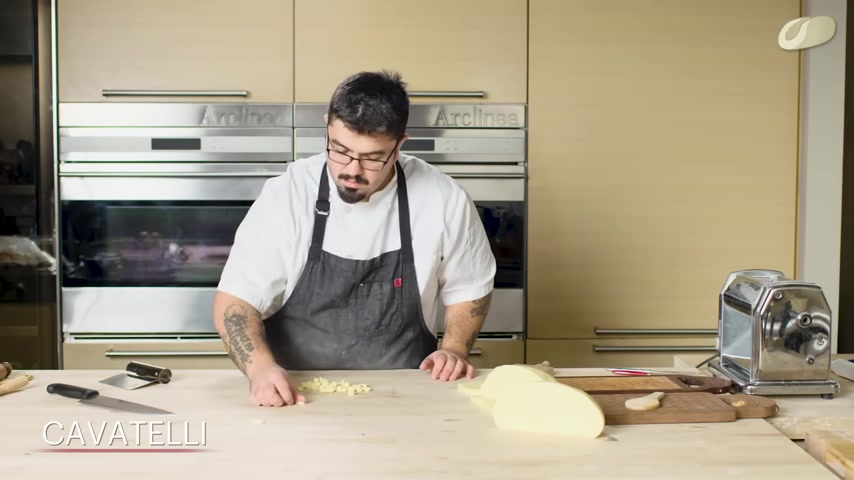
So , what I'm doing now is I'm taking my thumbs and I'm pressing down on those little pieces of dough as if to flatten them out .
But I'm rolling forward away from my body so as to make a nice grooved shape .
So that groove is good for picking up sauce .
So the next shape we're gonna make is or and literally means of , right ?
And yo , meaning just all these like little nuggets of dough if you will .
But so their true name and so these have the main groove that you've made much like , but on the outer side , they have the ridges which also help collect sauce .
So what we're using now is a board for .
And the idea behind this is it's very simple wooden tool that will impart texture .
Next up , we're gonna roll and we're gonna take this piece of dough and we're gonna roll it quite thin and you wanna make sure it's nice .
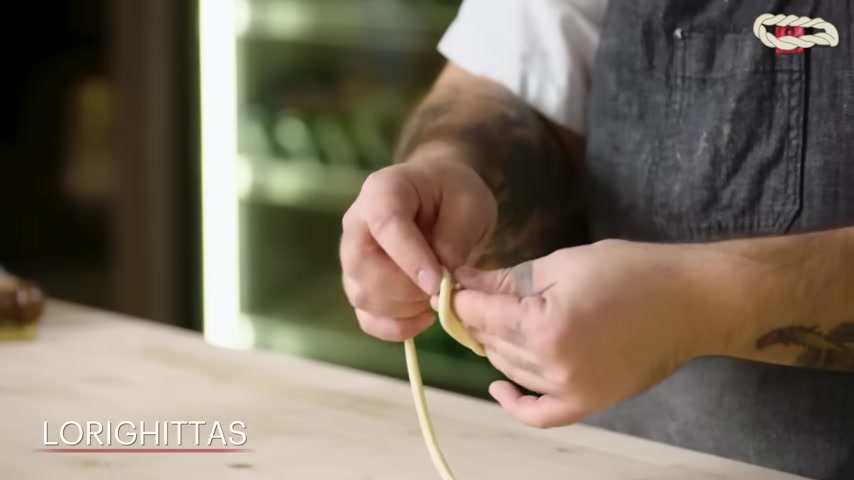
And even the next thing I'm gonna do is I'm gonna take the end of the rope and I'm gonna wrap it around my three fingers .
So as to make two rings and just kind of interlace the two rings to make a braid .
The word comes from Riga Lori was actually the kind of brace they would put around the ent and it looked very much like that .
It was just kind of this big braided rope .
And traditionally , in , you would see this with perhaps like a sausage Ragu , but you could also see something as simple as just with some tomato sauce .
Next shape I'm making is C and C literally are little rags in Italian .
So I'm gonna take my butter knife , a knife that's not too sharp .
Something that has a serrated edge and what I'm gonna do is I'm gonna keep it at a 45 degree angle from my work surface .
And I'm gonna allow the dough to just kind of be gently dragged under it .
With my other hand , I'm holding the other side of the dough flat .
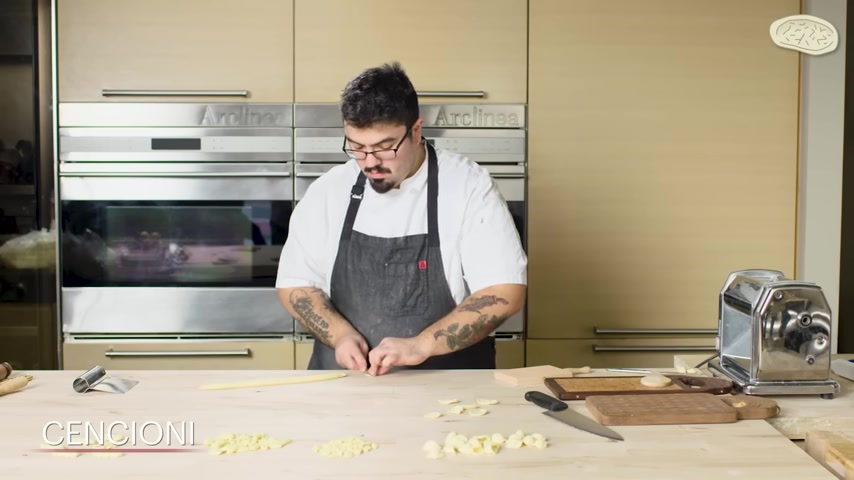
I want to keep it in place as it kind of stretches and drags out that dough into an elongated round shape I'm going to make next can be found kind of all over the southern regions .
What makes Kaun special is , it's dragged across the board .
And Cala board are handcrafted wooden boards and the pattern on the board can change .
But most times you would see kind of um a cross hatching and that imparts a beautiful texture .
I'm just going to roll them off the same way I did with the Cavatelli only off the Karola board .
I think this is maple wood .
It's always unfinished wood though all of your pasta tools should be an unfinished raw wood surface .
It'll allow it to attach itself to your pasta dough just right without sticking to it .
But it also pull the moisture off of it as needed next .
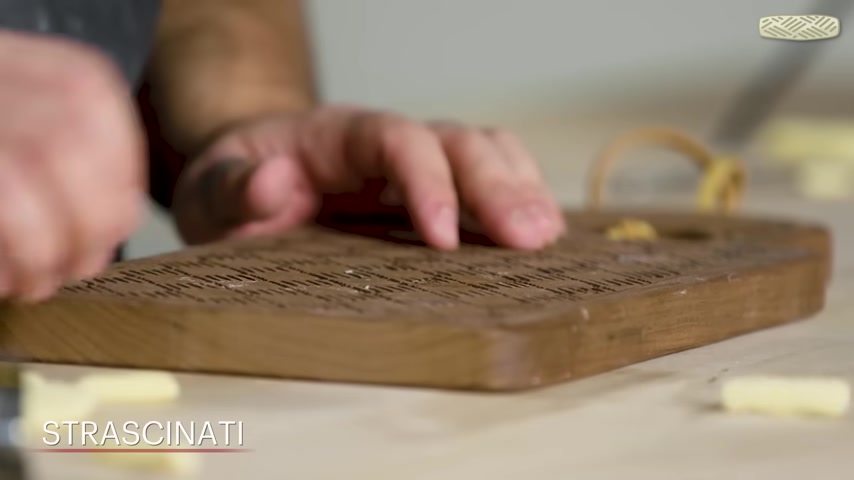
I'm going to make , I'm going to put my Karola board flat down on the surface and I'm going to dig my two fingers into it and drag them towards me and as it imparts that beautiful texture .
I'm just going to kick it off of the board next up , I'm gonna make these are from as well .
So this is another pasta .
So you'll notice that the dough is still in the bag where it's resting .
We wanna keep the dough wrapped up at all times .
So as not to form a skin or begin to air dry for laminating pasta dough , I start at the largest setting on my pasta Laminator .
As I work it through , I continue to work my way down to the thinnest setting until we have our desired thickness .
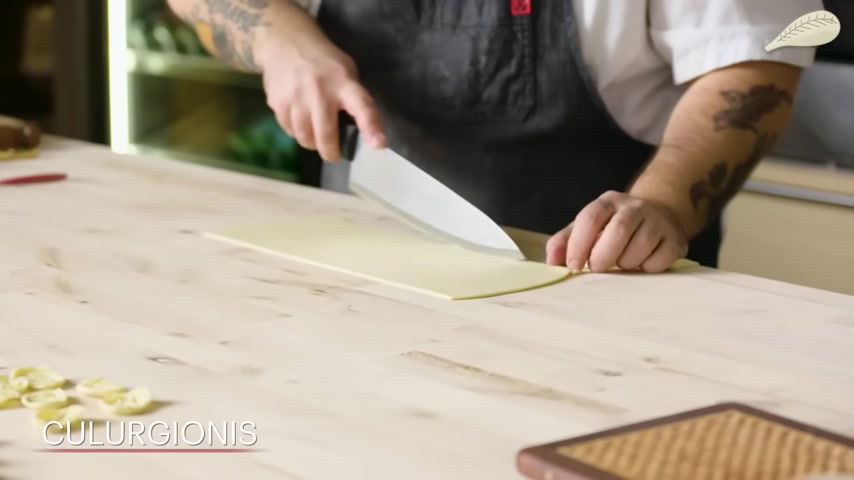
You never want to stress out the dough that you don't want to jump from 10 to 4 because oftentimes it's squeezing more dough through the Laminator wheels than it can handle and it'll augment the shape and what you want is a nice even consistent sheet of dough to work from now , once I have my sheet of dough , I'm just going to clean it up a little bit .
Cut the piece I need to work from next .
I'm taking this ring mold and you can use a cookie cutter at home or a cup , anything like that .
And I'm going to cut out these circle shapes from my sheet of pasta I'm making .
And what's traditional with that is a potato filling often with pecorino and mint .
So what I'm gonna do is I'm gonna take one of these circular pasta disks and I put just enough potato filling right in the center and I kind of fold it in one hand .
So as if to make uh a taco shape , if you will .
And then with my other hand , my free hand , I'm gonna start to pinch the dough close and some of the potato filling will fall out of the back end .
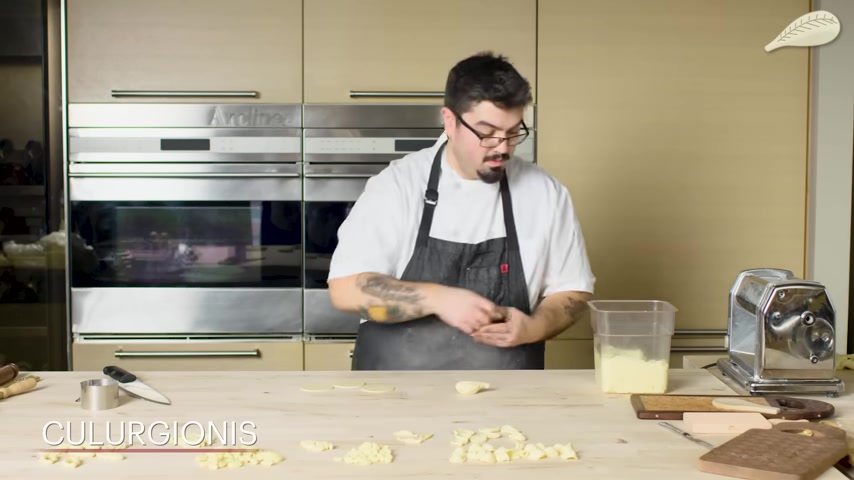
And that's to ensure that there's absolutely no air in my and that they're nice and full with potato filling .
And then at the very end as I get to the tail , I just squeeze them close .
So as to make that little tail tip end of the are a beautiful from , but they're very difficult to make your dough .
Hydration has to be just right .
It is always made with semolina and water dough and the potato filling works best .
Traditionally speaking , these are of course boiled in plenty of salted water and then paired most traditionally with actually a very simple tomato sauce .
So next , I'm going to sheet out another piece of this dough and I'm going to just trim the ends and I'm going to use the or bicycle to actually make nice even strips .
If you don't have at home , you can just use a knife and very , very steady hands .
The strip should not be too long and you'll see why in a moment .
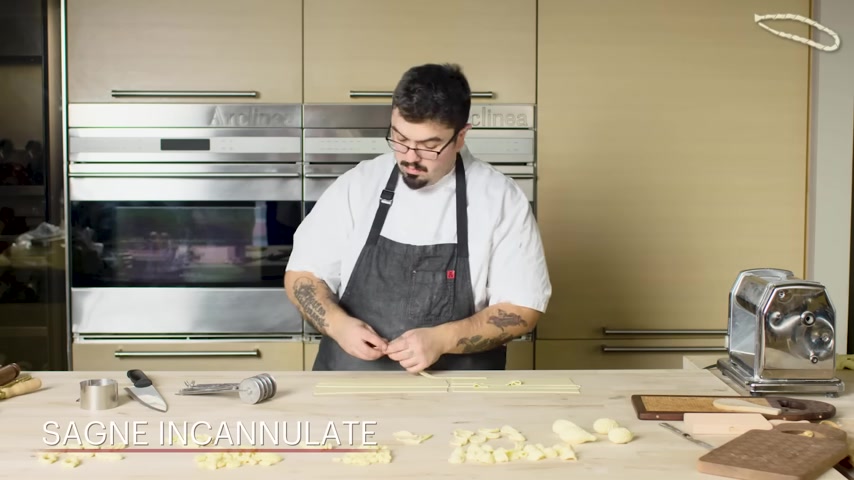
So as I'm holding the one end of the strip of dough with my right hand , I'm going to just gently roll them forward .
So as to make that spiral shape .
Once you've made the spiral all the way through , turn the dough into itself and you make these kind of shapes .
So here is , or just , and these are from and a pasta shape that's intricate like this .
When they dry , they will keep their shape even after they're cooked , but they must be allowed to dry all the way through first .
So here are all the pasta shapes we've made with our semolina and water dough .
Next up , I'm going to make pasta shapes from the egg dough .
So this is a dough that's more traditional of Northern Italy .
It's got an abundance of a fresh egg .
Of course , it also has a higher proportion of egg yolk to egg white .
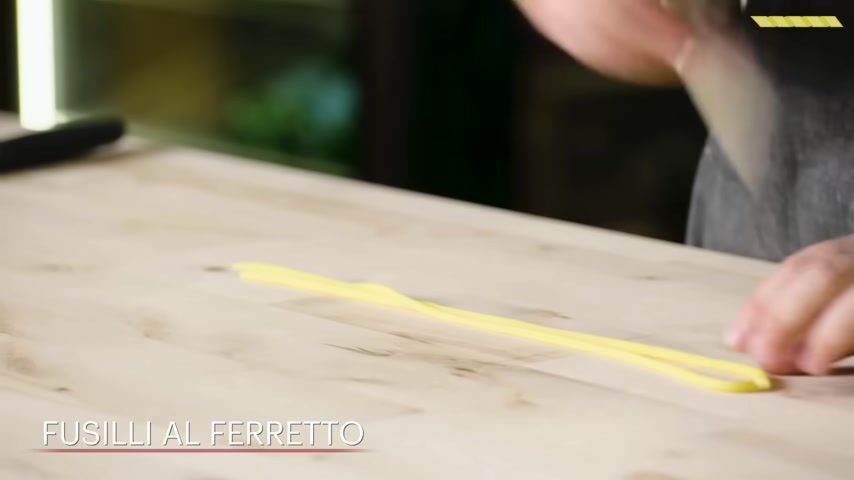
You'll see this kind of dough made with white flour , sometimes zero flour , sometimes or a very soft , low protein white flour .
The first shape I'm going to make is FF can come in all different shapes and sizes .
I would say this iteration is the precursor to the , you know , from out of the box , the dried pasta .
So the length of the pieces should be about two inches or so .
And then I'm going to situate it under my iron rod under my , I'm going to attach the end of the piece of dough just around the iron rod .
And then I'm going to roll all the way forward and make a beautiful spiral shape .
I'm rolling them thin and then I'm just attaching them to the rod by turning them over onto the end of the rod and create that spiral and very gently slide it right off .
The next thing I'm going to make is Tale Hails from Bologna and Emilio Roman .
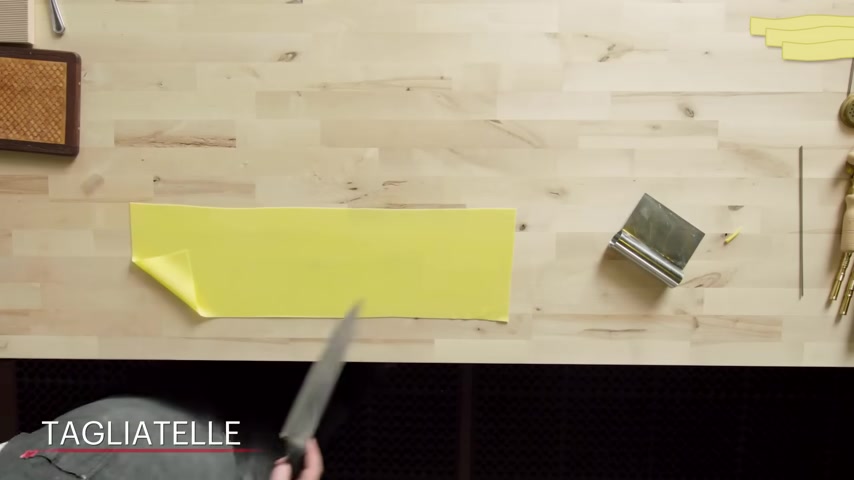
And very traditionally , the little old Bose ladies would use a to roll out las or the sheet of pasta .
The pasta sheet las should be thin enough that you could read the newspaper through it essentially .
Next , I'm going to add a little bit of bench flour to my sheet .
If your pasta dough happens to be a little bit more wet , you can add as much bench flour as you need .
And next , I'm going to just kind of roll up the pasta sheet lengthwise , not so tight that it's like a fruit roll up , but just flat enough so that it's easy for me to cut .
It's more conducive for me to cut straight .
And even at this point , it's important to consider how wide your pasta should be .
Tale is traditionally a little more narrow than fettucine , maybe just a quarter of an inch , perhaps wide .
And then once I'm done , I push them all together and open them up and just set them aside to dry a little bit or more appropriately right in the freezer .
If you want them , maybe during the week next , I'm going to make Tortellini .
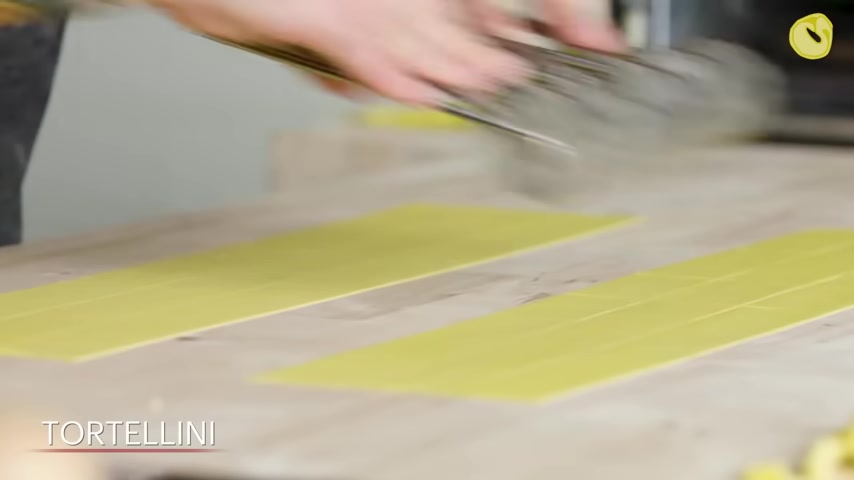
These are tortellini bone is also held from Bologna in Emilio uh typically the bolognese would pretty much make the tortellini and the from the same sheet of pasta .
So the consistency we just discussed , that's exactly the same consistency I'm looking for , for making these tortellini .
So here I'm going to use the again and I'm gonna make nice even squares .
Tortellini should never be too big .
They should be a little bigger than a quarter .
Tortellini are traditionally served in Bologna in broth .
So you don't want them to be too enormous .
And considering how hardy the filling is , you don't want too much of it at once either .
I'm just hydrating the dough a bit with my atomizer with my spray bottle so I can work on it without having to worry about it forming a skin or having the air dry it out too much .
Now , I have my filling and this is beautiful prosciutto pork filling .
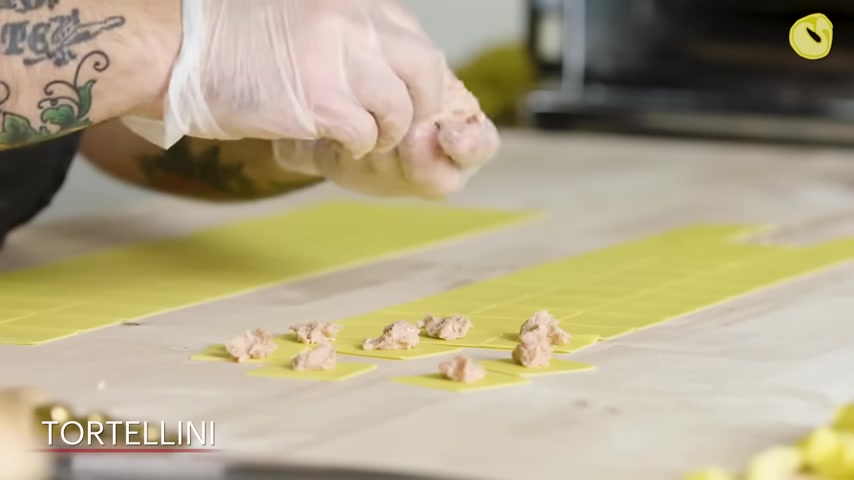
I'm going to take a piece of filling out at a time and I kind of roll it out and just with my free hand , pinch a piece of the filling off and attach it to each square of my pasta .
You never want to overstuff them because once you realize there's too much filling , there's no going back next .
I'm going to form the Tortellini .
So I pick up each square with my filling now and you want to form a triangle first .
So I meet the two corners at the top and have those connect and then I work my thumb and my index fingers all the way down .
So as to kind of push any excess air out while sealing the sheet of dough also , then the next part is a little tricky , but you fold one side of that triangle and then the other and then gently wrap them around your index finger .
So as to make kind of a ring and that is the up next , I'm going to make two different pasta , two different ravioli .
One is , and the other is tortelli piti .
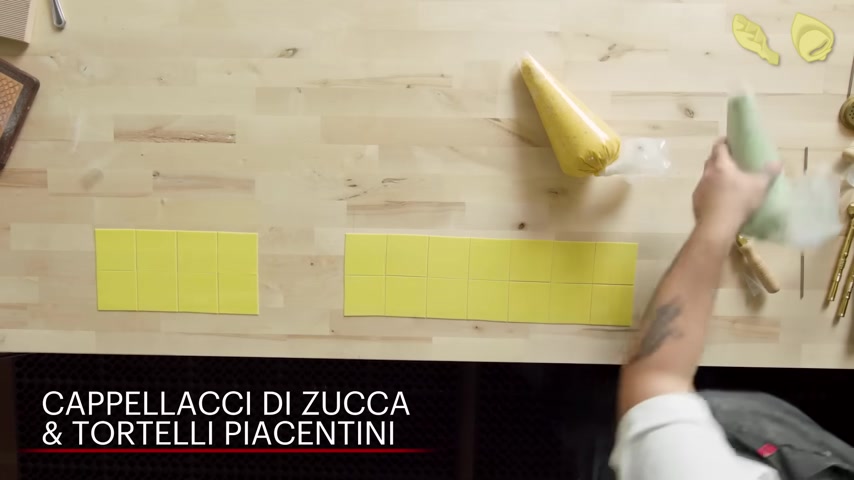
But we can use the same dough to make both shapes .
They're just different fillings and different shapes and we start from squares here as well .
However , when I use my here , I'm gonna make sure that the squares are a little larger .
So the tortellini were very small , whereas the capaci are a little bit bigger , unlike forming the filling with my hands , I'm using a pastry bag here .
If the filling is a little thinner and creamy and in that case , you can use a pastry bag to lay down your filling .
The filling here is a fairly thin filling of pumpkin puree cap or to can be found all over central to northern Italy .
Zucca is pumpkin capi literally big hats in Italian .
And you'll see why in a moment , the Tor Pini from Pia and is typically a spinach ricotta filling .
And I want just enough again , it's all proportionate to the square of pasta .
It should fit comfortably just in the center without running close to the edges of your pasta square .
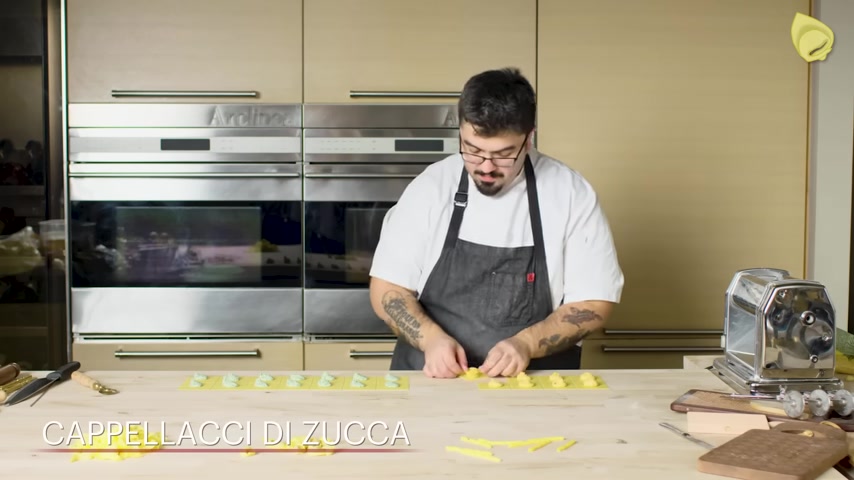
For the cap dico , we begin the same way that we did for the Tortellini .
So what I'm going to do is I'm going to meet the two corners together to make a triangle and again , kind of expelling the air .
So what I want to do is press down firmly to get all the air out around the filling and seal and then I pick up and I form the two arms around each other again , to form kind of a ring .
I want to make sure that I pinch the two arms together .
I don't want these to open up and unfurl in the water when they cook or I'll still just be triangles .
The Tortellini from Pienza are very difficult to make much like the colon .
They include a weaving style of closing the pasta .
So basically , I'm going to take my square sheet of pasta and I'm going to bring one of the corners in over the filling and then continue to overlap the excess pasta dough on either side , alternating one at a time until it's completely sealed all the way to the end .
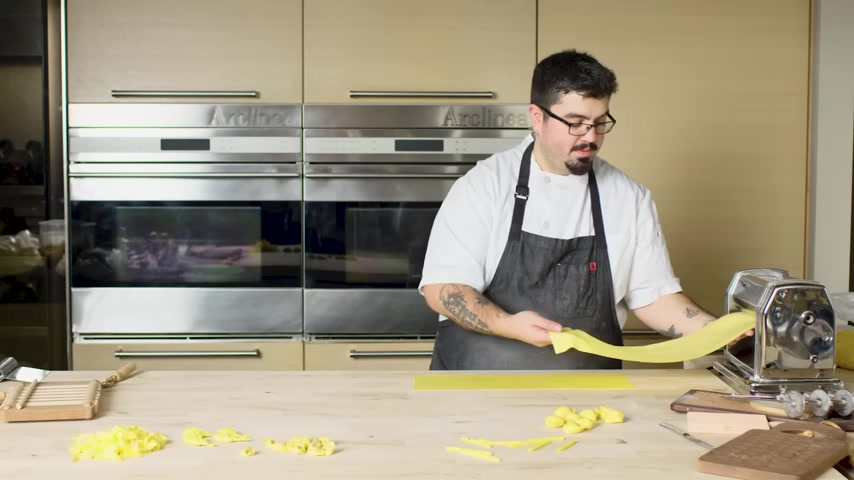
At the very end .
When I have just enough pasta dough left , I kind of seal it with a tail .
Next , I'm going to make as many of you may know at home as bow ties , but literally in Italian or butterflies fairly simple to make .
The only thing you need here is a good sharp knife or the pasta , your pasta cutting wheel with a fluted edge .
So what I start with , I use the or just cut strips and once you do that , you go the other direction and you use your fluted cutter and you want to cut long strips .
So they're about , I would say an inch by half an inch .
Next , I'm going to pick up each one .
And what I do is I go as if to fold this little piece of dough in half , stop halfway and then fold back in the opposite direction .
Uh So as to kind of quarter this piece of dough , next , I'm going to make some are actually region specific as well .
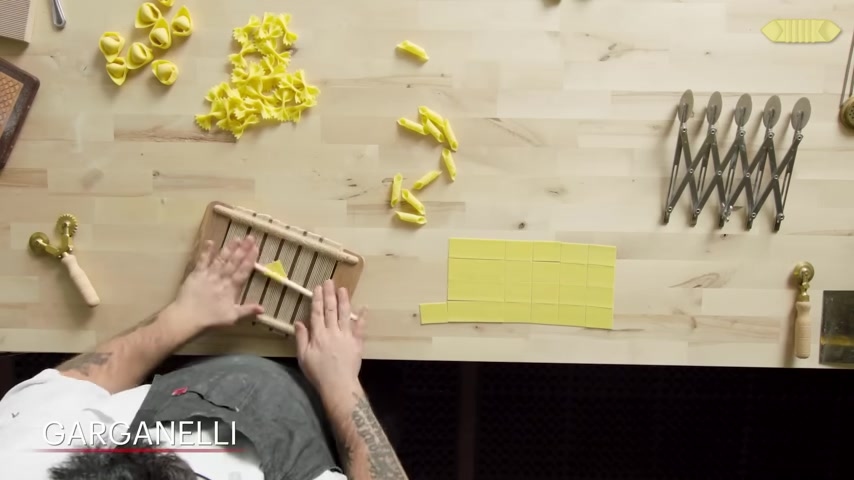
Are from Roman that you can actually work with the same egg dough that you've made your with and going to cut squares from it .
And then what you're going to do is you take a gnocchi board , I'm going to use my peti here , which is traditionally a weaver's comb , which is what they used to use in Italy back in the day .
So I'm going to put the quiz of pasta down flat on my pet and gently roll the dough over onto it , making sure that the very end of the corner of my dough kind of attaches to itself .
So for the next shape , an you'll find uh actually all over Central Italy and sometimes in northern Italy but are typically found again in that region that loves to use egg pasta so much .
So for an very , typically is just filling you could do and spinach if you like .
But this is just a nice creamy , very delicious cow's milk or .
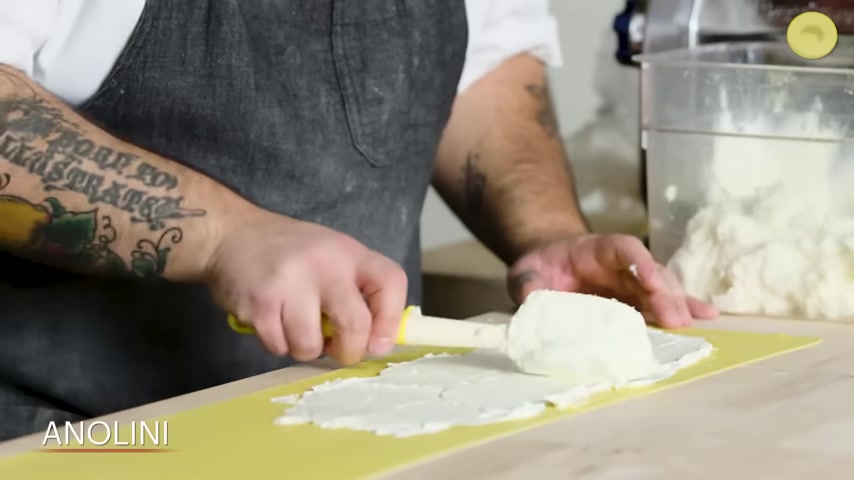
So , first thing I'm gonna to do , take a spatula and just spread the ricotta across half of your sheet of pasta and you wanna make it thin and even and then very carefully with the other half , I'm going to put it right over and very gently starting from the middle , working my way out , press out the dough and make sure there's no air pockets or air bubbles of any kind in there .
So for this folks at home are gonna need a uh stamp .
I use these beautiful bronze tools I got from Italy .
It's very basic to use very easy and you can just very simply stamp each a out and you have these really little tiny round dimples of pasta and they're , they're really beautiful , really delicious .
Next up is and are little hats .
And I want to start with again , a very nice thin sheet and I'm going to cut circles from it , either with my ring mold or with a cookie cutter you can use at home , something like that .
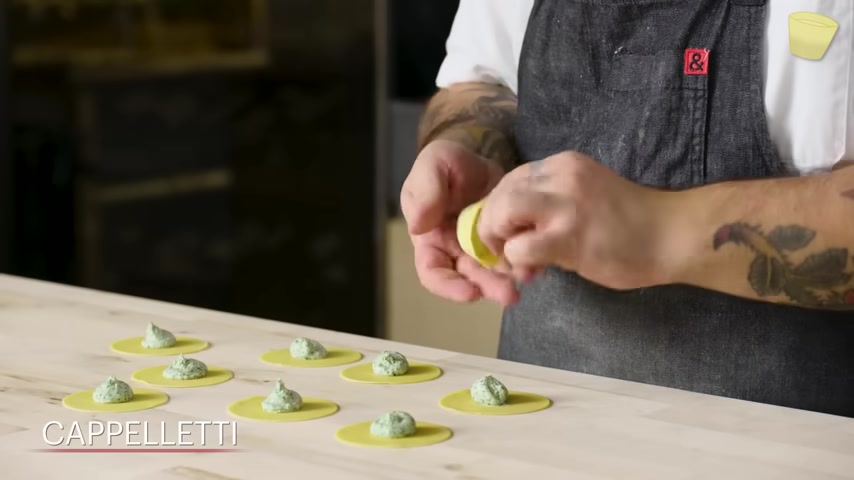
And the for this is again , I'm gonna use the spinach ricotta filling .
This is appropriate or you can do just plain ricotta .
Keep in mind your ravioli filling should always be again creamy .
Not too thick , not too dry , not too thin , but most importantly , homogenous .
So for these , I'm going to take up the disc and with my fingers , I'm just gonna start my way at the very top .
Once I've connected the edges , I'm gonna work my way out .
And once I have a semi circle or a Mezzaluna , I'm going to kind of wrap them around my two middle fingers and connect the two ends of my Mezzaluna to make the next up is another pasta .
I'm going to make a tali .
So like you want to take your pasta sheet and flour it a little bit of bench flour and then just roll it up .
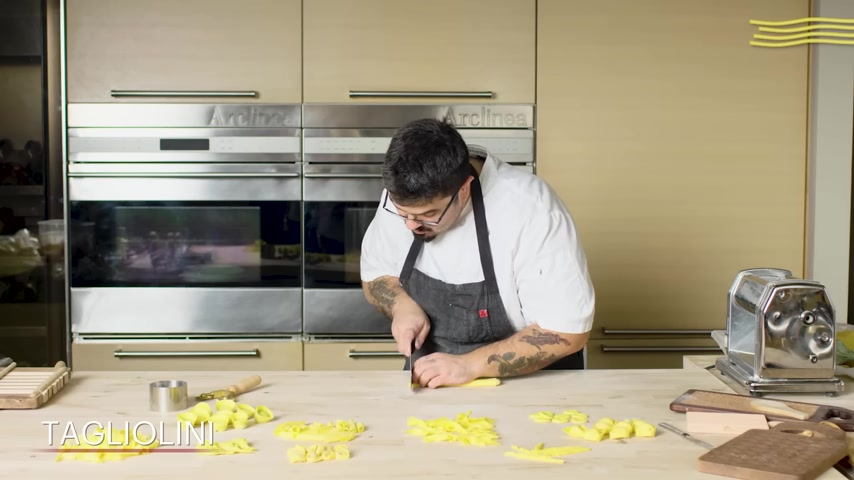
But this time we're going to cut a little bit more narrow , the thickness of the sheet should be about the same as the , if you do any thicker than that , it's a completely different pasta shape .
Tali should be nice and thin and very , very narrow .
And once you've done this , you'll have tali and I have nice even thin strips of my beautiful egg pasta dough .
Next , I'm going to make a a is a very generic term for filled pasta .
So what you need is your pasta sheet .
You want it nice and thin , have your filling ready in a pastry bag and you're going to lay them out just a little dollop at a time and just leave enough space in between .
Now , once I've had them all down .
I'm going to take half of the sheet and just overlap it to the top .
And next , I'm going to take my hands and I'm going to seal in between each dollop of filling .
I use my hand as a curve tool if you will and just kind of press the air out and seal at the top .
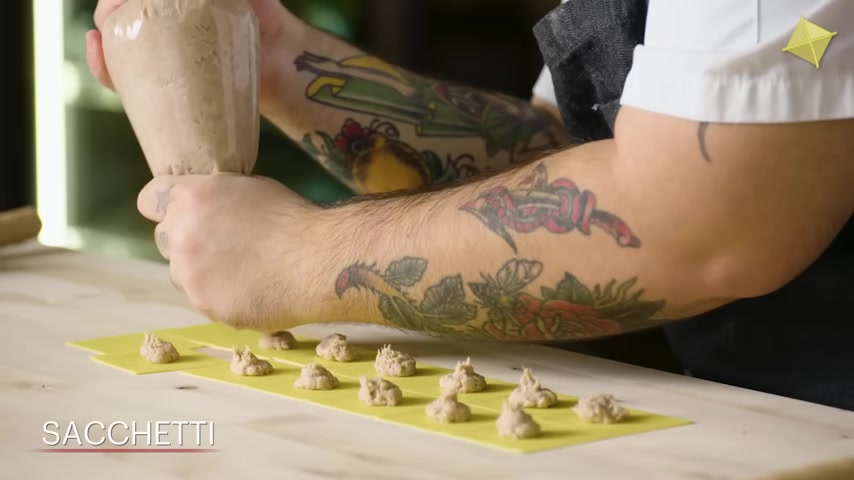
And then I'm going to use my to just cut in between .
So I trim the excess off the top first and then go down the way lengthwise and make each individual rectangular rao next up is or sometimes also called uh and those literally mean little bundles or little parcels respectively in Italian .
So , what I'm going to do is I start from the squares of pasta dough and your filling here should be nice and creamy .
It shouldn't be anything too , too dry and again , nothing too , too wet .
The sake are not necessarily region specific .
Uh They don't have a long history so you can really use whatever filling you like and whatever preparation you would like .
So what I'm going to do is from my square of pasta dough .
I'm going to attach two of the corners on one side and the other two corners from the opposite side .
Once I've done that , I'm going to meet those corners together over the top of the filling .
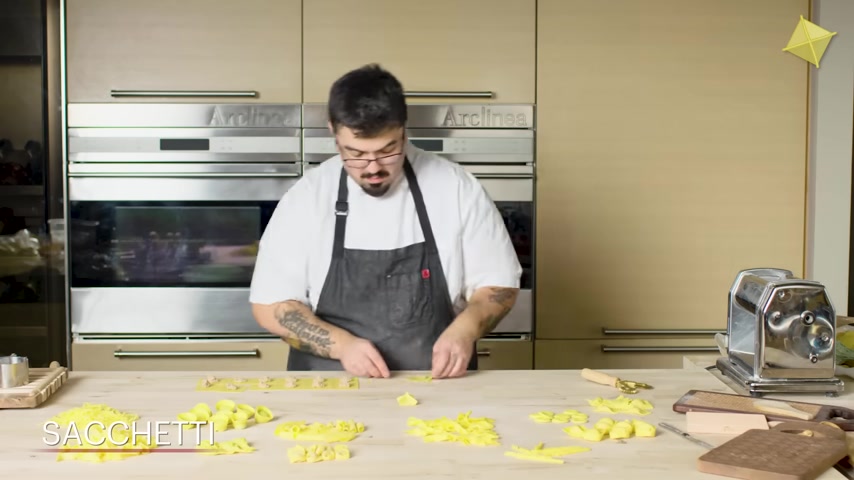
And once I've done that , I can work my way down each edge , all four of them to create kind of this pyramid if you will .
And these come in all shapes and sizes sometimes or fati will look actually much more like a parcel .
Uh They're actually very similar to a certain dim sum .
We share a lot of shapes when it comes to pasta , pasta originally is from China to begin with .
So a lot of the shapes are shared and this you'll see in a lot of dim sum restaurants actually .
And here are all of the pasta shapes that we've made from our egg pasta dough .
Up next , I'm going to make some pasta shapes using the spinach dough .
So here I have this beautiful spinach dough .
It's made with blanched , pressed and pureed fresh spinach .
And when I've added it to the dough , I've only added by the total weight , perhaps 20% .
So , what I typically do is I'll start with the same ingredients for the semele and water dough .
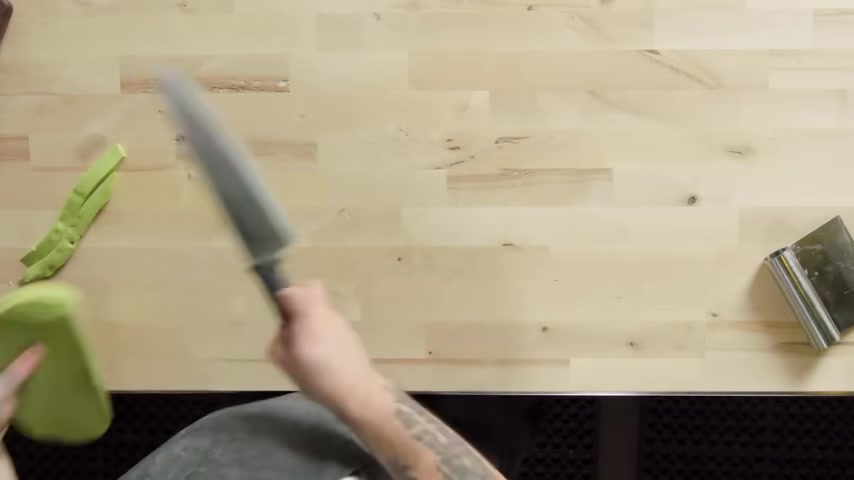
It allows it to have enough strength because when you add something like a vegetable additive , it can make the final product a little too tender .
So first thing I'm going to make with the spinach dough is literally olive leaves and Italian .
So I'm gonna take my butter knife and I'm going to drag them much in the way I did with the , the only difference here is that you don't drag them out as far as you would have for you .
Stop a little short with , I'm making a thin tapered piece of dough .
And I'm going at it with the butter knife lengthwise .
So it's to make kind of a skinny , tight oval that tapers on the end .
So they kind of look like a long , thin leaf , much like the olive leaf .
The next thing I'm going to make is something that's a little less traditional as far as the green spinach do goes .
But I'm going to make spinach originally come from and most often you'll see them actually made sometimes with potato , sometimes with stale bread , they can be made with all these different ingredients .
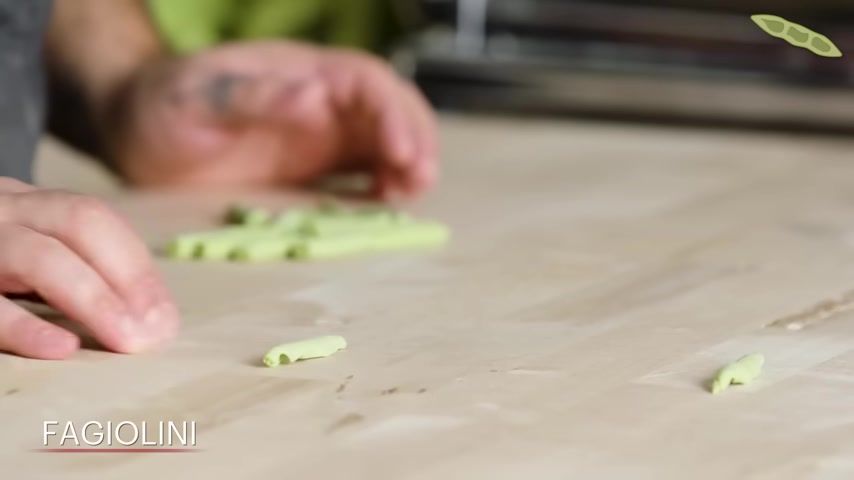
Once I have my little pieces of dough about the size of a dime , nice round pieces .
I'm going to roll them out and then I'm gonna take my Ben scraper and I'm going to use the edge of it and just kind of roll against it .
So as to make these nice simple twists , they're not quite spirals that we've seen before , but they're just slightly twisted pieces of pasta dough .
Next , I'm going to make one of my favorites .
I'm going to make Fali Fali literally in Italian beans .
And these you'll see are very much like little bean pots .
You want to roll out the rope fairly thin about pencil thickness .
So I take a long piece of dough from my rope , I would say about an inch wide and you just want to roll it under your palm .
So it tapers a little bit once I've done that .
I'm going to take three fingers and just simply dig the tips of my fingers into the dough and drag it towards me until it gently rolls off my hand .
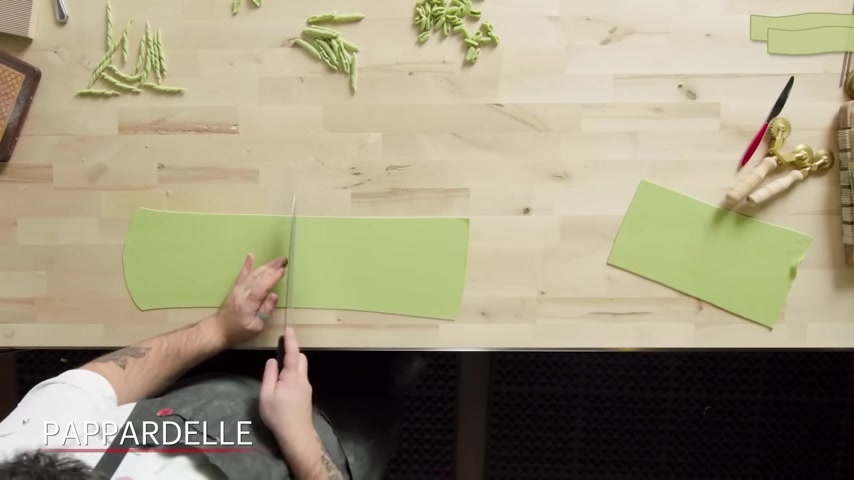
Next , I'm going to make some , I start from a sheet of pasta and the should not be too long .
So you wanna make sure you cut almost a square piece out of your sheet of pasta though and just like the , and the , I'm going to add a little bit of bench flour .
And once you've rolled it up , I do the maybe three quarters of an inch to an inch thick .
Whenever you cut pasta lung , that's very wide .
You want to make sure that they're not too long either because a long pasta that's also very wide would eat very strangely .
It doesn't twirl up on the fork very easily .
And it's not easy to pick up in one bite .
So once I've rolled these up and cut them , I just break them apart and you can add a little extra bench flour to hold on to them a bit .
Or they can be frozen or dried out and kept for a little bit .
And next , I'm going to make the macaroni a and this beautiful wooden tool is called a literally guitar in Italian .
It's a wooden box essentially .
And it has these guitar strings strung tightly across it .
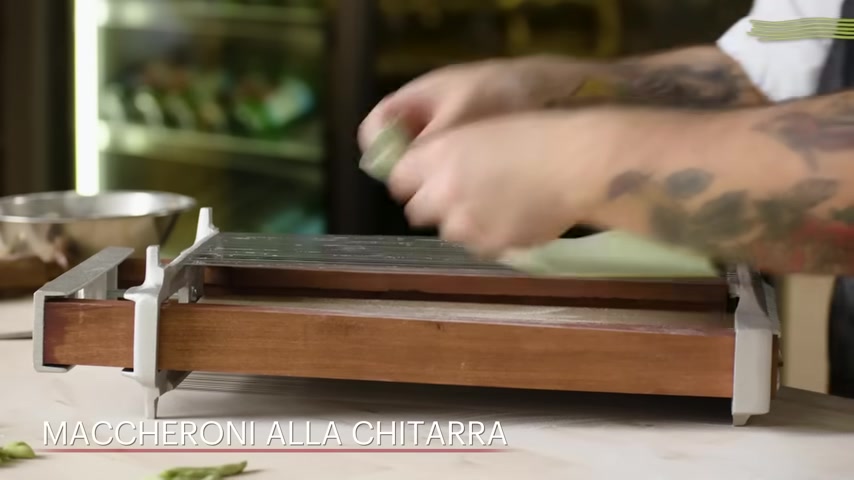
So the first thing I'm going to do is I'm going to sheet out a new piece of spinach dough and I don't want it to be too , too thin because what I'm making is a little thick .
So I'm going to take this sheet and I'm going to add a little bit of bench flour to it .
And next , I'm going to place it on top of my , over the strings and I'm going to take my Mazzello or a rolling pin or whatever you can use .
And I'm going to put a lot of pressure down and roll over it .
So it cuts and it makes that beautiful spaghetti or macaroni .
Macaroni A comes from , it's a and this is a very old tradition of making this pasta and it's really beautiful and you can actually buy a online once I roll over and make sure that the strings cut all the way through to detach them from the strings .
I just add a little extra bench flower and just play the strings as if I were playing a harp and boom , they should fall right out nicely .
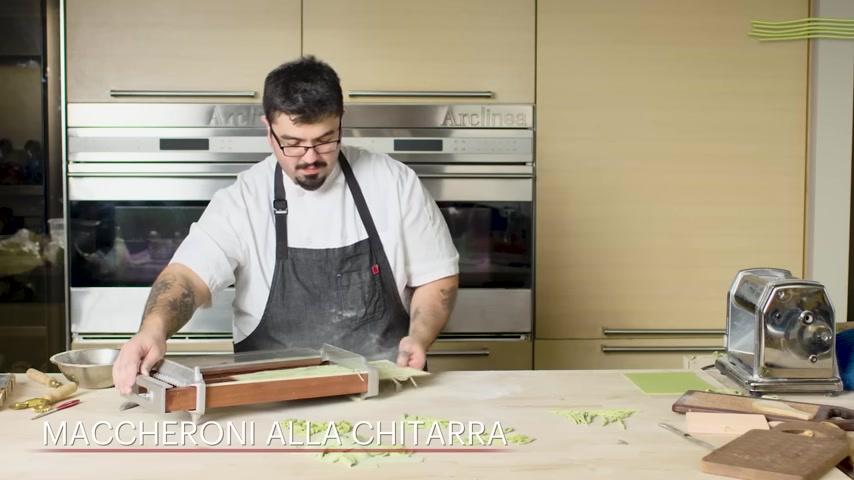
This is why you wanna make sure that the hydration of your dough , it's not over hydrated , it doesn't stick too much .
It should be able to cut using those guitar strings very easily .
These are the pastas I've made from the spinach dough and last up , I'm going to make some pasta shapes from the Squid ink dough .
So this is the pasta or Squid ink dough .
And I've made this one using cuttlefish ink .
It has kind of a briny taste to it .
It kind of smells almost like seaweed again , just like the spinach dough .
It's not necessary to add too much squid ink .
You maybe only want 10 to 20% of the way to be from the squid ink itself up .
First , I'm going to make some with this literally in Italian are little ears and they hail from .
So these are a tradition .
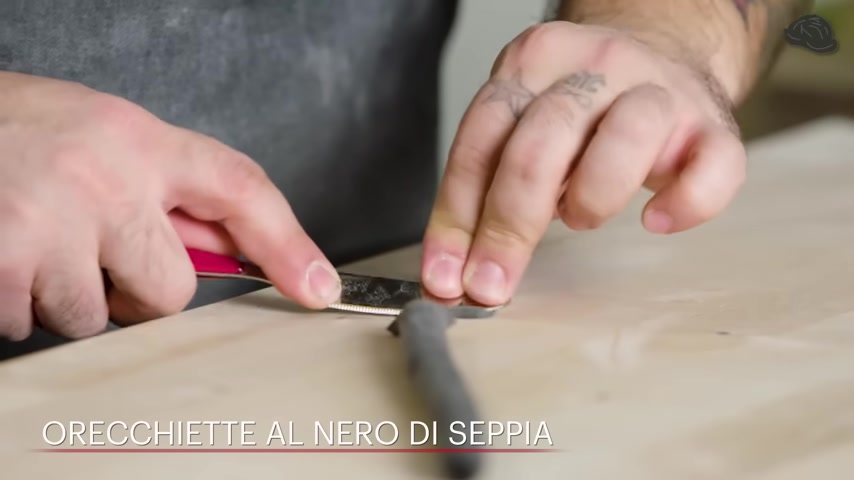
So I'm gonna take my butter knife and drag it across the table , allowing the dough to just kind of be dragged or stretched under the knife .
And as it's doing that , it's tearing up the surface of the dough .
And as I pick it up , I overturn it onto my thumb .
So that creates a concave shape .
And on the other side are those tears that were made by the serrated edge of the knife as well .
Next I'm going to make , which are very similar to the often times though , have flat ends .
So I used a fluted pasta wheel before and now I'm actually just going to use a straight edge pasta cutter and I'm going to use my , and I'm going to cut these rectangles out .
Once I've made my rectangles here , I'm going to make them in exactly the same fashion .
I made the , the beauty of this though is that they look much like black bow ties .
These can go very nicely with the f kind of like a seafood Ragu .
It's a very beautiful dish for guests .
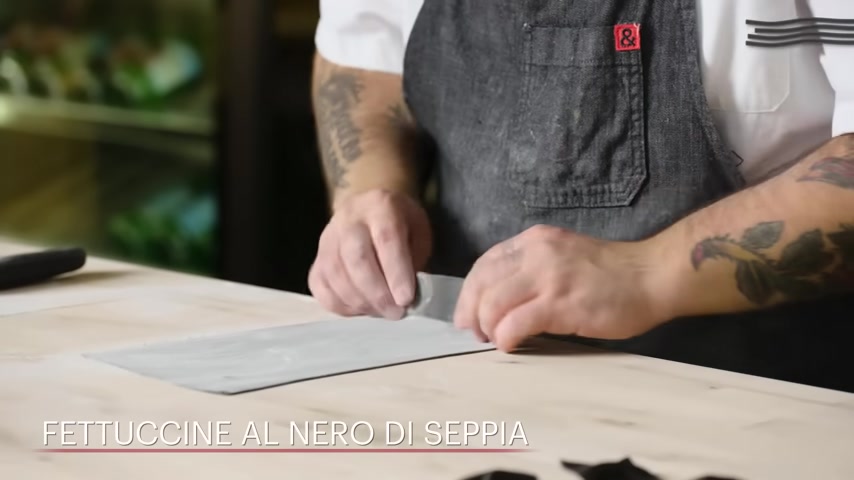
Next , I'm going to make some , you can definitely make any iteration of cut pasta you like from this .
So I'm going to make some , I'm gonna make mine a little bit more narrow and I made it in exactly the same fashion we did for the and for the .
So the same starting point can be made into a number of different permutations of pasta .
And last I'm going to make now come from , they're modeled after an old ancient coin from Laia where actually families would have their coat of arms etched onto them .
This is very untraditional as far as go traditionally , go with uh basil pesto , but these would go nicely with , again , a or a sauce , pick your shellfish and just make a beautiful seafood Ragu .
And here are the pasta shapes we've made from the pasta .
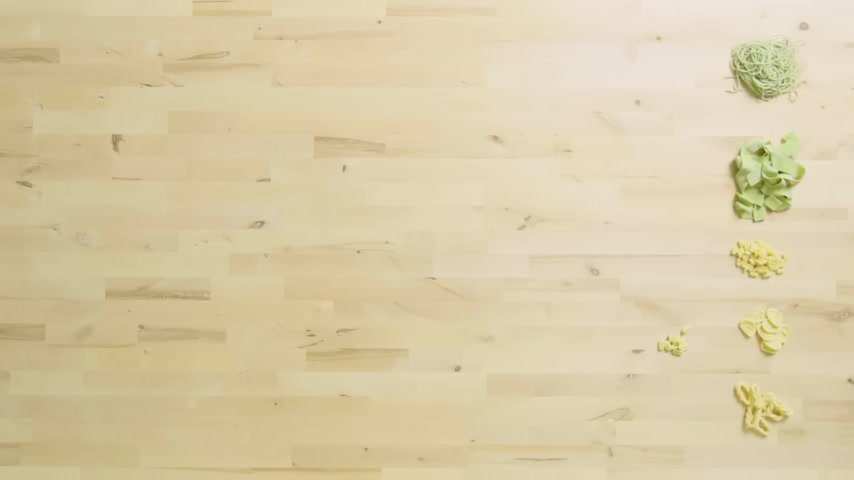
And finally , here are all the pastas I've made for you today .
Are you looking for a way to reach a wider audience and get more views on your videos?
Our innovative video to text transcribing service can help you do just that.
We provide accurate transcriptions of your videos along with visual content that will help you attract new viewers and keep them engaged. Plus, our data analytics and ad campaign tools can help you monetize your content and maximize your revenue.
Let's partner up and take your video content to the next level!
Contact us today to learn more.